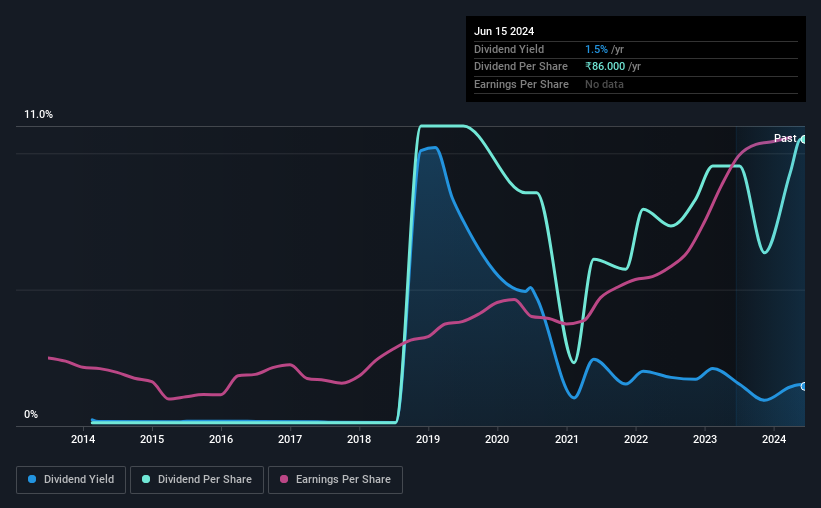ESAB India (NSE:ESABINDIA) Is Increasing Its Dividend To ₹30.00

ESAB India Limited's (NSE:ESABINDIA) dividend will be increasing from last year's payment of the same period to ₹30.00 on 7th of September. This takes the dividend yield to 1.5%, which shareholders will be pleased with.
Check out our latest analysis for ESAB India
ESAB India's Earnings Easily Cover The Distributions
A big dividend yield for a few years doesn't mean much if it can't be sustained. At the time of the last dividend payment, ESAB India was paying out a very large proportion of what it was earning and 118% of cash flows. This is certainly a risk factor, as reduced cash flows could force the company to pay a lower dividend.
Over the next year, EPS could expand by 23.1% if the company continues along the path it has been on recently. If the dividend continues along recent trends, we estimate the payout ratio could reach 79%, which is on the higher side, but certainly still feasible.

Dividend Volatility
The company has a long dividend track record, but it doesn't look great with cuts in the past. The dividend has gone from an annual total of ₹1.00 in 2014 to the most recent total annual payment of ₹86.00. This means that it has been growing its distributions at 56% per annum over that time. Despite the rapid growth in the dividend over the past number of years, we have seen the payments go down the past as well, so that makes us cautious.
ESAB India Might Find It Hard To Grow Its Dividend
Given that the dividend has been cut in the past, we need to check if earnings are growing and if that might lead to stronger dividends in the future. We are encouraged to see that ESAB India has grown earnings per share at 23% per year over the past five years. Fast growing earnings are great, but this can rarely be sustained without some reinvestment into the business, which ESAB India hasn't been doing.
ESAB India's Dividend Doesn't Look Sustainable
In summary, while it's always good to see the dividend being raised, we don't think ESAB India's payments are rock solid. While we generally think the level of distributions are a bit high, we wouldn't rule it out as becoming a good dividend payer in the future as its earnings are growing healthily. This company is not in the top tier of income providing stocks.
Companies possessing a stable dividend policy will likely enjoy greater investor interest than those suffering from a more inconsistent approach. Still, investors need to consider a host of other factors, apart from dividend payments, when analysing a company. Case in point: We've spotted 2 warning signs for ESAB India (of which 1 is potentially serious!) you should know about. If you are a dividend investor, you might also want to look at our curated list of high yield dividend stocks.
Valuation is complex, but we're here to simplify it.
Discover if ESAB India might be undervalued or overvalued with our detailed analysis, featuring fair value estimates, potential risks, dividends, insider trades, and its financial condition.
Access Free AnalysisHave feedback on this article? Concerned about the content? Get in touch with us directly. Alternatively, email editorial-team (at) simplywallst.com.
This article by Simply Wall St is general in nature. We provide commentary based on historical data and analyst forecasts only using an unbiased methodology and our articles are not intended to be financial advice. It does not constitute a recommendation to buy or sell any stock, and does not take account of your objectives, or your financial situation. We aim to bring you long-term focused analysis driven by fundamental data. Note that our analysis may not factor in the latest price-sensitive company announcements or qualitative material. Simply Wall St has no position in any stocks mentioned.
Have feedback on this article? Concerned about the content? Get in touch with us directly. Alternatively, email editorial-team@simplywallst.com
About NSEI:ESABINDIA
ESAB India
Manufactures and sells welding and cutting equipment and consumables in India.
Excellent balance sheet average dividend payer.


